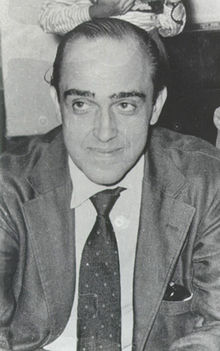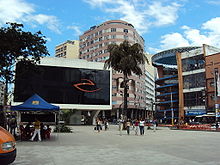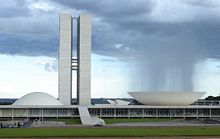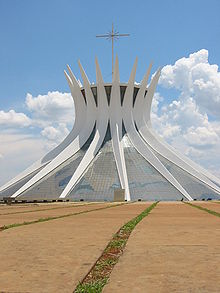- Oscar Niemeyer
-
Oscar Niemeyer 
Niemeyer in the 1950'sBorn December 15, 1907
Rio de Janeiro, BrazilNationality Brazilian Awards 1988 Pritzker Prize Work Buildings Edifício Copan
National Congress of BrazilProjects United Nations headquarters
City of BrasíliaDesign Cathedral of Brasília Oscar Ribeiro de Almeida Niemeyer Soares Filho (born December 15, 1907) is a Brazilian architect specializing in international modern architecture. He is a pioneer in exploring the formal possibilities of reinforced concrete solely for their aesthetic impact.
His buildings are often characterized by being spacious and exposed, mixing volumes and empty space to create unconventional patterns and often propped up by pilotis. Both lauded and criticized for being a "sculptor of monuments",[1] he has been praised for being a great artist and one of the greatest architects of his generation by his supporters.[2] His works include public buildings designed for the city of Brasília, and the United Nations Headquarters in New York City (with others).
“ It is not the right angle that attracts me, nor the straight line, hard and inflexible, created by man. What attracts me is the free and sensual curve – the curve that I find in the mountains of my country, in the sinuous course of its rivers, in the body of the beloved woman.[cite this quote] ” Contents
Early life
Oscar Niemeyer took his German surname from a German Brazilian grandmother with roots in Hanover, Germany. He was born in the city of Rio de Janeiro in 1907 in Laranjeiras neighborhood, on a street that later would receive the name of his grandfather. He spent his youth as a typical young Carioca of the time: bohemian and relatively unconcerned with his future. He concluded his secondary education at age 21. The same year, he married Annita Baldo, daughter of Italian immigrants from Padua. They have one daughter, Ana Maria, five grandchildren, thirteen great-grandchildren and seven great-great grandchildren.
He started to work in his father's typography house and entered the Escola de Belas Artes (Brazil), from which he graduated as engineer architect in 1934. At the time he had financial difficulties but decided to work without payment in the architecture studio of Lúcio Costa and Carlos Leão. He felt dissatisfied with the architecture that he saw in the streets and believed he could find a career there.
In 1945, he joined the Brazilian Communist Party, and in 1992 he would become president of that party. Niemeyer was a boy at the time of the Russian Revolution of 1917, and by the Second World War he became a young idealist. During the military dictatorship of Brazil his office was raided and he was forced into exile in Europe. The Minister of Aeronautics of the time reportedly said that "the place for a communist architect is Moscow." He visited the USSR, met with diverse socialist leaders and became a personal friend of some of them. Fidel Castro once said: "Niemeyer and I are the last Communists of this planet."[cite this quote]
First works
In 1936, at 29, Lúcio Costa was appointed by Education Minister Gustavo Capanema as the architect of the new headquarters for the Ministry of Education and Public Health in Rio de Janeiro. In 1939, Niemeyer assumed the leadership of the team of architects (Lúcio Costa, Carlos Leão, Affonso Eduardo Reidy, Jorge Moreira, Ernani Vasconcellos and Niemeyer, with Le Corbusier acting as a consultant) responsible for the Ministry that had assumed the task of shaping the ‘novo homem, Brasileiro e moderno’ (new man, Brazilian and modern).
Following Niemeyer's request, the headquarters were renamed Palácio Gustavo Capanema in 1985. It was the first state-sponsored modernist skyscraper in the world, and of a much larger scale than anything Le Corbusier had built until then. Completed in 1943, when he was 36, the building which housed the regulator and manager of Brazilian culture and cultural heritage developed the elements of what was to become recognized as Brazilian modernism. It employed local materials and techniques, like the azulejos linked to the Portuguese tradition; the revolutionized Corbusian brises-soleil, made adjustable and related to the Moorish shading devices of colonial architecture; bold colors; the tropical gardens of Roberto Burle Marx; the Imperial Palm (Roystonea oleracea), known as the Brazilian order; further allusions to the icons of the Brazilian landscape; and specially commissioned works by Brazilian artists.
In 1939, at 32, Niemeyer with Lúcio Costa designed the Brazilian pavilion at the New York World's Fair (executed in collaboration with Paul Lester Wiener). Impressed by the executed Pavilion, Mayor Fiorello La Guardia awarded Niemeyer the keys to the city of New York. Costa explained that the Brazilian Pavilion adopted a language of ‘grace and elegance’, lightness and spatial fluidity, open plan, curves and free walls, which he termed ‘Ionic’, contrasting it to the contemporaneous stern Modernist architecture, which he termed ‘Doric’. By mid-twentieth century, Brazilian architectural Modernism had been recognized as the first national style in modern architecture by Reyner Banham. The international architectural periodicals of the 1940s and 1950s dedicated hundreds of dithyrambic pages to the ‘chosen land of the most original and most audacious contemporary architecture’, followed by monographs on individual architects like Niemeyer and Affonso Eduardo Reidy.
The Pampulha project
In 1940, at 33, Niemeyer met Juscelino Kubitschek, who was at the time the mayor of Belo Horizonte, capital of the state of Minas Gerais. He and Minas Gerais Governor Benedito Valadares wanted to develop a new suburb to the north of the city called Pampulha, and commissioned Niemeyer to design a series of buildings to be known as the "Pampulha complex". Brazil’s first listed modern monument was Niemeyer’s Pampulha Church of São Francisco de Assis (English: Church of Saint Francis of Assisi). The Pampulha complex included a casino, a dance hall and restaurant, a yacht club, and a golf club distributed around the artificial lake. A weekend retreat for the mayor was also constructed near the lake.
The buildings were completed in 1943, and provoked some controversy. They received international acclaim following the 1943 ‘Brazil Builds’ exhibition, at the New York Museum of Modern Art (MoMA). The conservative Church authorities of Minas Gerais refused to consecrate the church until 1959, in part because of its unorthodox form, in part because of the altar mural painted by Candido Portinari. The mural depicts Saint Francis of Assisi as the savior of the ill, the poor and, most importantly, the sinner.
Pampulha, says Niemeyer, offered him the opportunity to 'challenge the monotony of contemporary architecture, the wave of misinterpreted functionalism that hindered it, and the dogmas of form and function that had emerged, counteracting the plastic freedom that reinforced concrete introduced. I was attracted by the curve – the liberated, sensual curve suggested by the possibilities of new technology yet so often recalled in venerable old baroque churches. […] I deliberately disregarded the right angle and rationalist architecture designed with ruler and square to boldly enter the world of curves and straight lines offered by reinforced concrete. […] This deliberate protest arose from the environment in which I lived, with its white beaches, its huge mountains, its old baroque churches, and the beautiful suntanned women.'[3]
The 1940s and 1950s
 Ministries Esplanade with several Niemeyer's buildings: the National Congress, the Cathedral, the National Museum and the National Library, Brasilia, D.F., 2006
Ministries Esplanade with several Niemeyer's buildings: the National Congress, the Cathedral, the National Museum and the National Library, Brasilia, D.F., 2006
In 1947, at 40, his worldwide recognition was confirmed when Niemeyer traveled to the United States to be part of the international team working on the design for the headquarters of the United Nations in New York. Niemeyer's 'scheme 32' was approved by the Board of Design, but he eventually gave in to pressure by Le Corbusier, and together they submitted project 23/32 (developed with Bodiansky and Weissmann), which combined elements from Niemeyer's and Le Corbusier's schemes, but was primarily based on Niemeyer's scheme. Despite Le Corbusier’s insistence to remain involved, the conceptual design for the United Nations Headquarters (scheme 23/32), approved by the Board, was carried forward by the Director of Planning, Wallace Harrison, and Max Abramovitz, then a partnership. In the previous year Niemeyer had received an invitation to teach at Yale University; however, his visa was denied. In 1950 the first book about his work was published in the USA by Stamo Papadaki. In 1953, at 46, Niemeyer was selected for the position of dean of the Harvard Graduate School of Design. His Communist Party membership meant that, for the second time, he was refused a visa to enter the United States.
In Brazil, he designed São Paulo's Ibirapuera Park (for the celebrations of the city's 400th anniversary) 1951, the Copan apartment building (1953–66), and the JK Building in Belo Horizonte (1951). In 1952–53, he built his own house in Rio de Janeiro, the House at Canoas (Casa das Canoas), and, in 1954–60, the Niemeyer luxury apartment building in Belo Horizonte. In 1955, at 48, Niemeyer designed the Museum of Modern Art of Caracas (MAM Caracas). According to him, this project marked a new direction his work was beginning to take, exemplified by his government buildings for Brasilia.
It was at the Canoas House that Juscelino Kubitschek visited Niemeyer one September morning of 1956, soon after he assumed the Brazilian presidency. While driving back to the city, the politician ‘eagerly’ spoke to the architect about his most audacious scheme: ‘I am going to build a new capital for this country and I want you to help me […] Oscar, this time we are going to build the capital of Brazil.’[4]
Niemeyer organized a competition for the lay-out of Brasília, the new capital, and the winner was the project of his old master and great friend, Lúcio Costa. Niemeyer would design the buildings, Lucio the plan of the city.
In the space of a few months, Niemeyer designed a large number of residential, commercial and government buildings. Among them were the residence of the President (Palácio da Alvorada), the House of the deputy, the National Congress of Brazil, the Cathedral of Brasília (a hyperboloid structure), diverse ministries, and residential buildings. Viewed from above, the city can be seen to have elements that repeat themselves in every building, giving it a formal unity.
Behind the construction of Brasília lay a monumental campaign to construct an entire city in the barren center of the country, hundreds of kilometers from any major city. The brainchild of Kubitschek, Niemeyer had as aims included stimulating the national industry, integrating the country's distant areas, populating inhospitable regions, and bringing progress to a region where only cattle ranching had a foothold. Niemeyer and Lúcio Costa used it to test new concepts of city planning: streets without transit, buildings floating off the ground supported by columns and allowing the space underneath to be free and integrated with nature.
The project also had a socialist ideology: in Brasília all the apartments would be owned by the government and rented to its employees. Brasília did not have "nobler" regions, meaning that top ministers and common laborers would share the same building. Of course, many of these concepts were ignored or changed by other presidents with different visions in later years. Brasília was designed, constructed, and inaugurated within four years. After its completion, Niemeyer was nominated head chief of the college of architecture of the University of Brasília. In 1963, he became an honorary member of the American Institute of Architects in the United States; the same year, he received the Lenin Peace Prize from the USSR.
Niemeyer and his contribution to the construction of Brasília are portrayed in the 1964 French movie L'homme de Rio (The Man From Rio), starring Jean-Paul Belmondo.
In 1964, at 57, after being invited by Abba Hushi, the mayor of Haifa, Israel, to plan the campus of the University of Haifa, he came back to a completely different Brazil. In March President João Goulart, who succeeded President Jânio Quadros in 1961, was deposed in a military coup. General Castello Branco assumed command of the country, which would remain a dictatorship until 1985.
Exile and projects overseas
 Mondadori headquarters near Milan, Italy
Mondadori headquarters near Milan, Italy
The leftist position of Niemeyer (he was a staunch stalinist[5]) cost him much during the military dictatorship. His office was pillaged, the headquarters of the magazine he coordinated was destroyed, his projects mysteriously began to be refused and clients disappeared. In 1965, two hundred professors, Niemeyer among them, asked for their resignation from the University of Brasília, in protest against the government treatment of universities. In the same year he traveled to France for an exhibition in the Louvre museum.
The following year, Niemeyer moved to Paris. Also in 1966, at 59, he travelled to the city of Tripoli, Lebanon to design the International Permanent Exhibition Centre.[6] Despite completing construction, the start of the civil war in Lebanon prevented it from achieving its full utility.
He opened an office on the Champs-Élysées, and had customers in diverse countries, especially in Algeria where he designed the University of Science and Technology-Houari Boumediene. In Paris he created the headquarters of the French Communist Party (photos), Place du Colonel Fabien, and in Italy that of the Mondadori publishing company. In Funchal on Madeira, a 19th-century hotel was removed to build a casino by Niemeyer. Another prominent design of his was the Penang State Mosque in George Town the state capital of Penang, Malaysia in the 1970s.
While in Paris, Niemeyer began designing furniture which was produced by Mobilier International. He created an easy chair and ottoman composed of bent steel and leather in limited numbers for private clients. Later, in 1978, this chair and other designs including the "Rio" chaise-longue were produced in Brazil by the Japanese company Tendo, then Tendo Brasileira. The easy chairs and ottomans were made of bent wood and were placed in different Communist party headquarters around the world. Much like his architecture, Niemeyer's furniture designs were meant to evoke the beauty of Brazil, with curves mimicking the female form and the hills of Rio de Janeiro.1980s to 2000
In 1988, at 81, Niemeyer was awarded the Pritzker Architecture Prize, the most prestigious award in architecture, for the Cathedral of Brasília (1958).
From 1992 to 1996, Niemeyer was the president of the Brazilian Communist Party (PCB). As a lifelong activist, Niemeyer was chosen as a powerful public figure that could be linked to the party at a time when it appeared to be in its death throes after the demise of the USSR. Although not active as a political leader, his image helped the party to survive through its crisis, after the 1992 split and to remain as a political force in the national scene, which eventually led to its reconstruction. He was replaced by Zuleide Faria de Mello in 1996.
He designed at least two more buildings in Brasilia, small ones, the Memorial dos Povos Indigenas[7] ("Memorial for the Indigenous People") and the Catedral Militar, Igreja de N.S. da Paz.[8]
In 1996, at the age of 89, he created the Niterói Contemporary Art Museum in Niterói, a city next to Rio de Janeiro. The building is cantilevered out from sheer rock face, giving a view of the Guanabara Bay and the city of Rio de Janeiro.
2002 to present
 Municipal Library in city center, Duque de Caxias, RJ, Brasil
Municipal Library in city center, Duque de Caxias, RJ, Brasil
 Óscar Niemeyer International Cultural Centre Asturias, Spain
Óscar Niemeyer International Cultural Centre Asturias, Spain
The Brazilian dictatorship lasted until 1985. Under João Figueiredo's rule it softened and gradually turned into a democracy. At this time Niemeyer decided to return to his country. During that decade he made the Memorial Juscelino Kubitschek (1980), the Pantheon (Panteão da Pátria e da Liberdade Tancredo Neves Pantheon of the Fatherland and Freedom, 1985) and the Latin America Memorial (1987) (dubbed by The Independent of London to be "...an incoherent and vulgar construction"[9]). The memorial sculpture represents the wounded hand of Jesus, whose wound bleeds in the shape of Central and South America.
In 2002, at 95 the Oscar Niemeyer Museum complex was inaugurated in the city of Curitiba, Paraná. The building is locally known as "Niemeyer's Eye".
In 2003, at 96, Niemeyer was called to design the Serpentine Gallery Summer Pavilion in Hyde Park London, a gallery that each year invites a famous architect who has never previously built in the UK, to design this temporary structure. A publication of Niemeyer's structure called Serpentine Gallery Pavilion 2003 was published by Trolley Books later that year, ISBN 9781904563136.
In 2004, Niemeyer, at 97 designed the tombstone for Communist Carlos Marighella in Salvador da Bahia, to commemorate the 35th anniversary of his death. He was widowed after 76 years of marriage to Annita, Annita died at 93 years old. Also his brother Paulo Niemeyer died.
In 2005, at 98, a building entitled "Estação, Ciência, Cultura e Artes" (Science, Culture and Arts Station) was approved for construction at João Pessoa, the easternmost point of the Americas.[10]
In 2006, Niemeyer at the age of 99 wed longtime aide Vera Lucia Cabreira. They married at his apartment in Rio de Janeiro's Ipanema district a month after fracturing his hip in a fall.
2007 saw Niemeyer turn 100 and still involved in diverse projects, mainly sculptures and readjustments of old works of his that, protected by national (and some cases international) historic heritage regulations, can only be modified by him. He is currently designing a statue showing a tiger with its mouth open and a man fighting it raising the Cuban flag against the US blockade of Cuba.On Niemeyer's 100th birthday, Russia's president Vladimir Putin awarded him the Order of Friendship.[11] Grateful for the Prince of Asturias Award of Arts received in 1989, he collaborated on the 25th anniversary of these awards with the donation to Asturias of the design of a cultural centre. The actual Óscar Niemeyer International Cultural Centre (also known in Spain as Centro Niemeyer), is located in Avilés (Asturias) in Northern Spain. These modern buildings were described by himself as “a big square open to all men and women of the world, a big loge between the river and the ancient town". The Niemeyer Center was inaugurated during the spring of 2011.
In December 2008 when he turned 101, Niemeyer was recovering in hospital from December 16 to December 27. While in hospital he was as quoted saying that being hospitalized is 'a very lonely thing I needed to keep busy, keep in touch with friends, maintain my rhythm of life.'
In December of 2009 after he turned 102 Niemeyer was again hospitalized this time for 4 days, in the same hospital with an intestinal tumor, which was surgically removed. He is considered to be one of the fathers of modern architecture, remains professionally active and is currently working on several new projects.
In December of 2010 he turned 103 and opened a museum of his work. The Oscar Niemeyer Foundation outside Rio de Janeiro houses drawings and models from the modernist architect's 70-year career. "My friends have come to see me, how nice," Mr Niemeyer told reporters at the inauguration of his foundation in the city of Niteroi, outside Rio de Janeiro.
The Holoteca, a library specialized on consciousness and the paranormal, in the Cognopolis neighborhood of Iguassu Falls is one of his latest projects.
Criticism
Nicolai Ouroussoff, the architecture critic of the New York Times published an article questioning if his recent work is being affected by old age. He considers the "Niterói Contemporary Art Museum" to be of significantly lower quality than his previous works. Most notably, he argues that "the greatest threat to Mr. Niemeyer’s remarkable legacy may not be the developer’s bulldozer or insensitive city planners, but Mr. Niemeyer himself." He considers iconic works at "Esplanada dos Ministérios" to "have been marred by the architect’s own hand".[12]
See also
- List of Oscar Niemeyer works
- German Brazilian
References
- ^ Azure :: Niemeyer's Century
- ^ Niemeyer, Gullar, F.(in Portuguese)
- ^ Niemeyer, Oscar, 2000, The Curves of Time: The Memoirs of Oscar Niemeyer (London: Phaidon), pp. 62 and 169-70
- ^ Niemeyer, Oscar, 2000a, The Curves of Time: The Memoirs of Oscar Niemeyer (London: Phaidon), p. 70
- ^ "Elogios a Stalin e a busca pelo belo". http://diariodonordeste.globo.com/materia.asp?codigo=494208. Retrieved 03/08/2008.
- ^ Biography Oscar Niemeyer, architect
- ^ Memorial dos Povos Indigenas
- ^ Catedral Militar, Igreja de N.S. da Paz
- ^ "In search of... Oscar Niemeyer in Brazil". The Independent (London). July 6, 2003. http://www.independent.co.uk/travel/americas/in-search-of-oscar-niemeyer-in-brazil-586075.html. Retrieved May 20, 2010.
- ^ [1]
- ^ President Putin's executive order awarding Niemeyer the Order of Friendship
- ^ Nicolai Ouroussoff (December 26, 2007). "Even if His Own Work Isn’t Broken, a Brazilian Architect Fixes It". New York Times. http://www.nytimes.com/2007/12/26/arts/design/26niem.html?_r=1&hp=&oref=slogin&pagewanted=all. Retrieved December 26, 2007.
- Emery, Marc (1983). Furniture by Architects. New York: Harry N. Abrams.
- Niemeyer, Oscar (1983). The Curves of Time: The Memoirs of Oscar Niemeyer. London: Phaidon.
- A Vida É Um Sopro "Life Is A Breath Of Air" (2007). Documentary directed by Fabiano Maciel
External links
- Official website
- List and Locations of Oscar Niemeyer buildings around the world
- May 2006 Interview with Niemeyer, age 98, in Metropolis Magazine
- Paul Andreas, Ingeborg Flagge, ed. Oscar Niemeyer: A Legend of Modernism. Birkhäuser. http://www.arcspace.com/architects/Niemeyer/legend_modernism/.
- Niemeyer in Brasília history
- Niemeyer rosewood easy chair and ottoman at Noho Modern
- Contemporary Art Museum Niteroi.
- Tripoli International Fair by Oscar Niemeyer, 360 Panorama by Melkan Bassil
- Oscar Niemeyer's Strick House in Santa Monica
- JK Building, Belo Horizonte, Brazil
- Pritzker Prize 1988
- Images of The Museum of Contemporary Art, Niteroi, Cathedral of Brasilia, and Memorial dos Povos Indigenas (Memorial for the Indigenous People)
- Oscar Niemeyer group on Flickr
- Mondadori Headquarters
- Niemeyer's Brasilia: A Photographic Tribute (2009)
- Swerve with verve: Oscar Niemeyer, the architect who eradicated the straight line by Peter Godfrey in The Independent April 18, 2010
Pritzker Architecture Prize laureates Philip Johnson (1979) · Luis Barragán (1980) · James Stirling (1981) · Kevin Roche (1982) · I. M. Pei (1983) · Richard Meier (1984) · Hans Hollein (1985) · Gottfried Böhm (1986) · Kenzo Tange (1987) · Gordon Bunshaft and Oscar Niemeyer (1988) · Frank Gehry (1989) · Aldo Rossi (1990) · Robert Venturi (1991) · Álvaro Siza Vieira (1992) · Fumihiko Maki (1993) · Christian de Portzamparc (1994) · Tadao Ando (1995) · Rafael Moneo (1996) · Sverre Fehn (1997) · Renzo Piano (1998) · Norman Foster (1999) · Rem Koolhaas (2000) · Herzog & de Meuron (2001) · Glenn Murcutt (2002) · Jørn Utzon (2003) · Zaha Hadid (2004) · Thom Mayne (2005) · Paulo Mendes da Rocha (2006) · Richard Rogers (2007) · Jean Nouvel (2008) · Peter Zumthor (2009) · Kazuyo Sejima and Ryue Nishizawa / SANAA (2010) · Eduardo Souto de Moura (2011)
Categories:- Brazilian architects
- Ecclesiastical architects
- Brazilian centenarians
- Brazilian socialists
- Brazilian communists
- Brazilian atheists
- Anti-Revisionists
- Brazilian Order of Scientific Merit recipients
- International style architecture
- Modernist architects
- 20th-century architects
- 21st-century architects
- Pritzker Prize winners
- Lenin Peace Prize recipients
- Orden de las Artes y las Letras de España recipients
- People from Rio de Janeiro (city)
- Brazilian people of German descent
- 1907 births
- Living people
- Recipients of the Royal Gold Medal
- Architects of cathedrals
- Recipients of the Order of Friendship
- Brazilian Marxists
Wikimedia Foundation. 2010.








